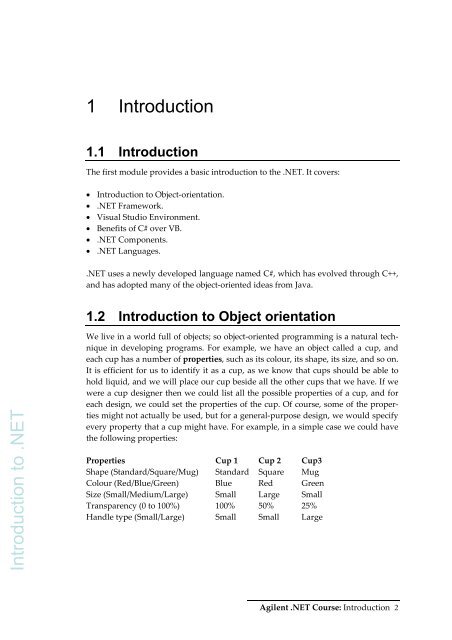Complete set: Intro to C - Bill Buchanan
Complete set: Intro to C - Bill Buchanan
Complete set: Intro to C - Bill Buchanan
Create successful ePaper yourself
Turn your PDF publications into a flip-book with our unique Google optimized e-Paper software.
1 <strong>Intro</strong>duction<br />
1.1 <strong>Intro</strong>duction<br />
The first module provides a basic introduction <strong>to</strong> the .NET. It covers:<br />
• <strong>Intro</strong>duction <strong>to</strong> Object‐orientation.<br />
• .NET Framework.<br />
• Visual Studio Environment.<br />
• Benefits of C# over VB.<br />
• .NET Components.<br />
• .NET Languages.<br />
.NET uses a newly developed language named C#, which has evolved through C++,<br />
and has adopted many of the object‐oriented ideas from Java.<br />
1.2 <strong>Intro</strong>duction <strong>to</strong> Object orientation<br />
duction <strong>to</strong> .NET<br />
<strong>Intro</strong><br />
We live in a world full of objects; so object‐oriented programming is a natural technique<br />
in developing programs. For example, we have an object called a cup, and<br />
each cup has a number of properties, such as its colour, its shape, its size, and so on.<br />
It is efficient for us <strong>to</strong> identify it as a cup, as we know that cups should be able <strong>to</strong><br />
hold liquid, and we will place our cup beside all the other cups that we have. If we<br />
were a cup designer then we could list all the possible properties of a cup, and for<br />
each design, we could <strong>set</strong> the properties of the cup. Of course, some of the properties<br />
might not actually be used, but for a general‐purpose design, we would specify<br />
every property that a cup might have. For example, in a simple case we could have<br />
the following properties:<br />
Properties Cup 1 Cup 2 Cup3<br />
Shape (Standard/Square/Mug) Standard Square Mug<br />
Colour (Red/Blue/Green) Blue Red Green<br />
Size (Small/Medium/Large) Small Large Small<br />
Transparency (0 <strong>to</strong> 100%) 100% 50% 25%<br />
Handle type (Small/Large) Small Small Large<br />
Agilent .NET Course: <strong>Intro</strong>duction 2










![Unit 5. Switches and VLANs [PDF]](https://img.yumpu.com/34422504/1/184x260/unit-5-switches-and-vlans-pdf.jpg?quality=85)





